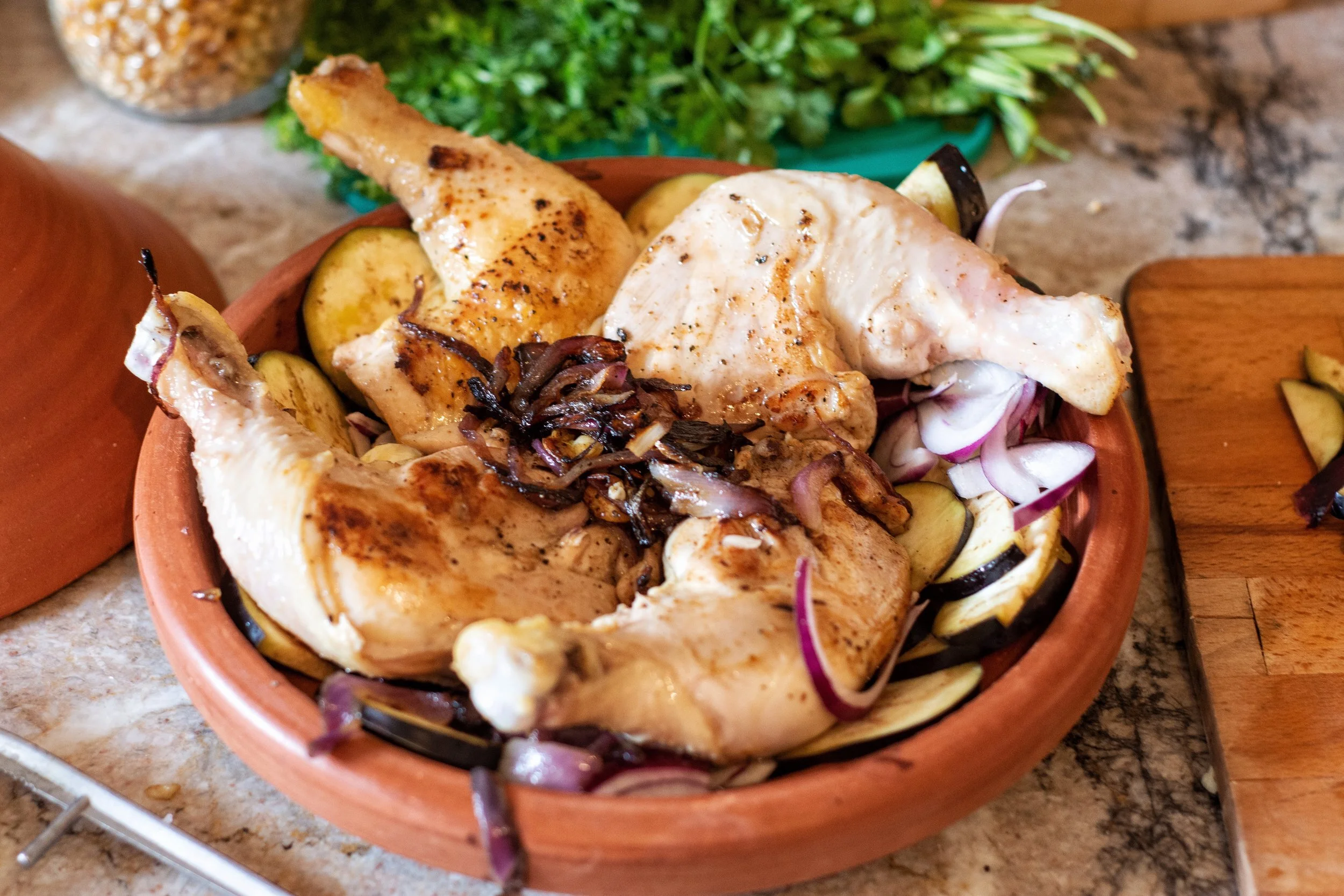Moroccan Chicken with Preserved Lemons & Olives
The tagine, an essential vessel of traditional Moroccan cuisine.
In Morocco, old ways of cooking are still very much alive, like this family recipe, chicken with preserved lemons and olives sourced from Abdullah, a local olive merchant in the Casablanca Habous quarter.
Rich in spices and prepared in a tagine, this popular dish slowly cooks until the chicken is falling off the bone on the inside and crispy on the outside.
The tagine, a clay cooking vessel and Morocco’s most famed cooking tool, is built in two pieces: a round flat plate with shallow sides and a large cone-shaped cover that sits on the base. Functional and decorative, they’re sold at most markets a variety of sizes and colors, from earthy tones to vibrant hues. Nearly every household in Morocco has at least one.
The magic of the tagine is the closed design that allows for steam to rise and then return to the bottom of the dish with limited water loss. This method of cooking was developed millennia ago by the Berbers (desert nomads of North Africa) to compensate for limited water supplies.
While times have changed and potable water is readily available in Morocco, the tagine has stuck around as a rich emblem of local cuisine and a part of Morocco’s material culture. A tagine refers to both the vessel itself and a variety of finished dishes cooked in it. Large Moroccan families still eat a tagine meal once a week, cooked by the grandmothers and mothers of the household.
It is customary to eat a tagine with bread to sop up the flavorful vegetable and meat juices, so you may want to add a rustic loaf to your dinner table.
Note: While a traditional tagine is used to cook this recipe, in its absence a cast iron casserole dish with a lid can be used with similar results.
Serves 3 - 4
Ingredients:
4 large chicken thighs, skin on
Salt and pepper
2 large red onions
4 garlic cloves
5 tablespoons olive oil
2 medium eggplants
1 lemon, juiced
1 teaspoon powdered ginger
1 teaspoon powdered turmeric
1 teaspoon powdered cumin
2 preserved lemons
200g of green pitted olives
4 tablespoons fresh coriander
Instructions:
Heat oven to 300°F.
Generously salt and pepper the chicken on both sides, set aside.
Cut one onion into thick slices. Chop 2 garlic cloves. Cook in a pan with olive oil on medium heat for 2 minutes.Turn heat up to medium high. Add the chicken and brown until slightly crispy, around 10 minutes, turning several times.
Slice both eggplants into 1-inch-thick disks, lightly salt. Lay on the bottom of tagine with slices overlapping. Place browned chicken, sauteed garlic and onions from the pan on top of eggplant.
Chop remaining 2 garlic cloves.
Pour ¾ cups of water and the lemon juice into tagine. Toss in 2 chopped garlic cloves.
Remove any excess oil in the pan used to brown the chicken, then add ginger, turmeric and cumin. Toast on low heat for 2 minutes, stirring often. Use a spoon to evenly sprinkle spice mixture over chicken. Spice mixture will be hot so be careful not to burn your fingers when sprinkling.
Cover the tagine with lid and put it in the oven for 45 minutes.
While the tagine cooks, cut the preserved lemons into 4 wedges each, roughly chop olives and fresh coriander, set aside.
Remove tagine from oven. Make sure the liquid hasn’t evaporated. If needed add ¼ cup of water. Toss in the green olives and preserved lemon wedges and sprinkle chopped coriander. Replace lid and return to oven for another 30 minutes.When done, the eggplant should be steamed soft and the chicken cooked through but still crispy on the outside. Serve hot with a side of couscous and bread to soak up those juices.







